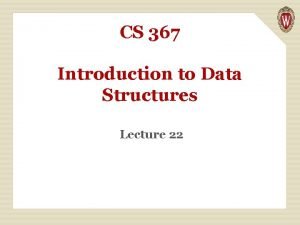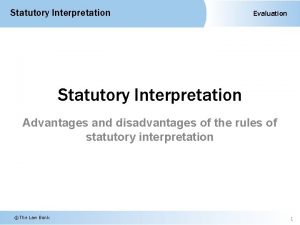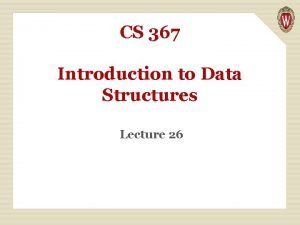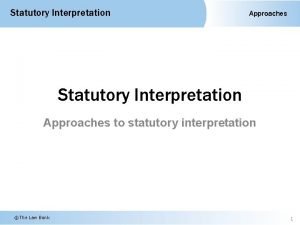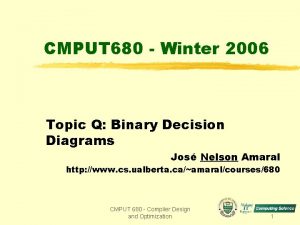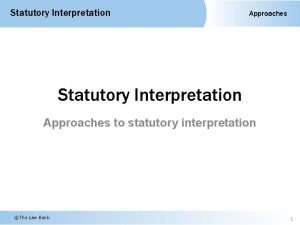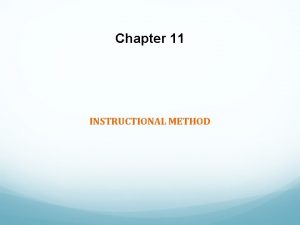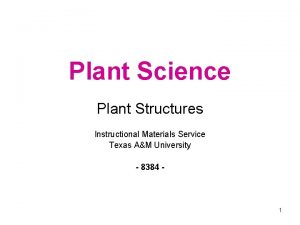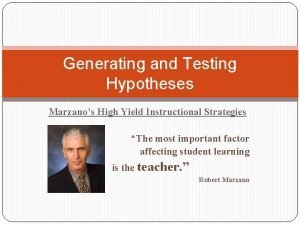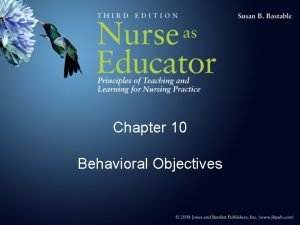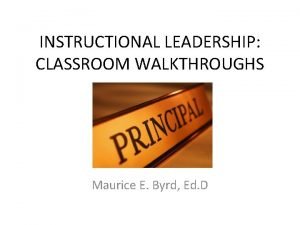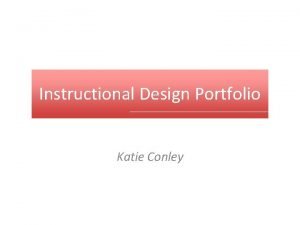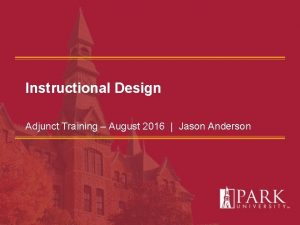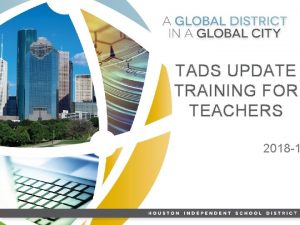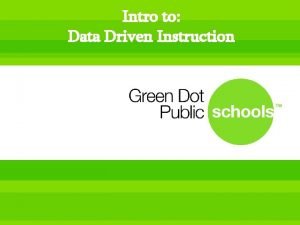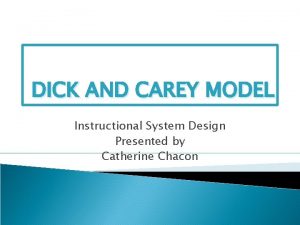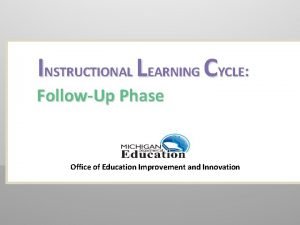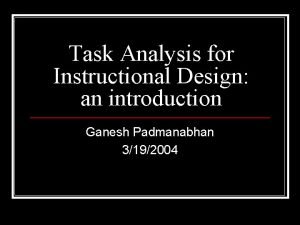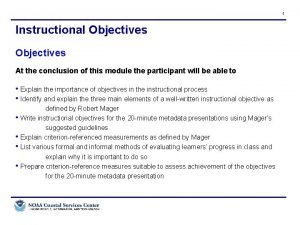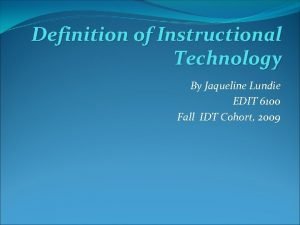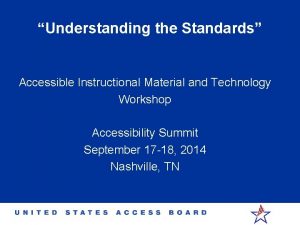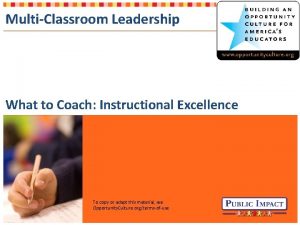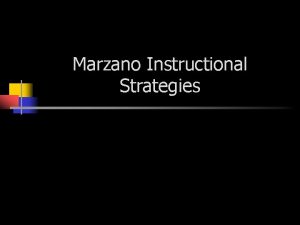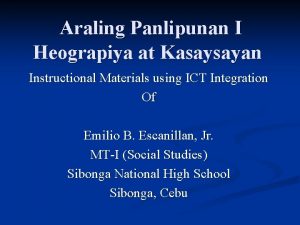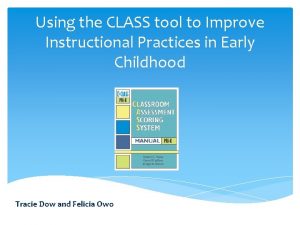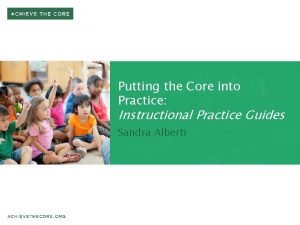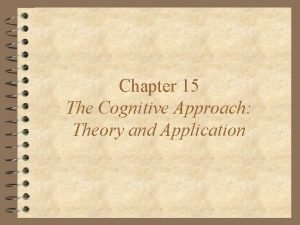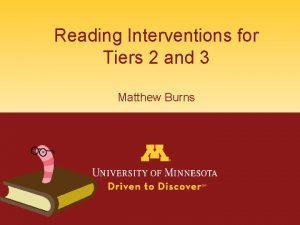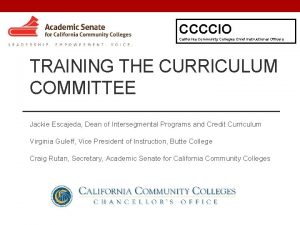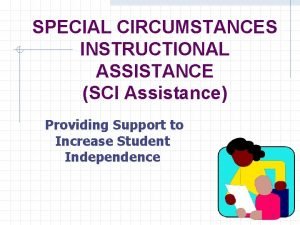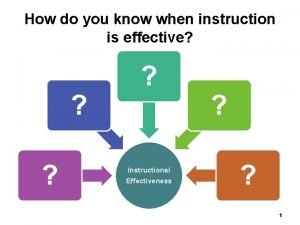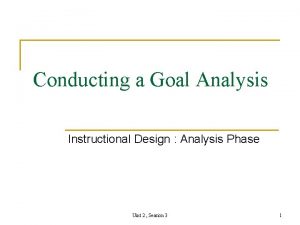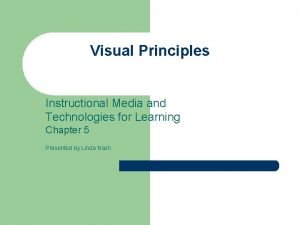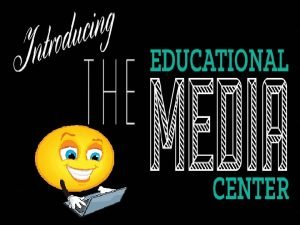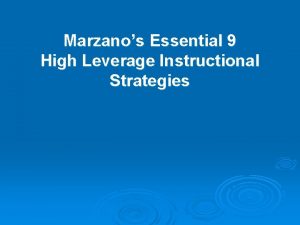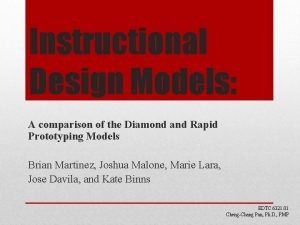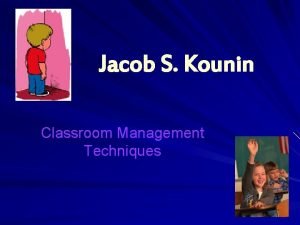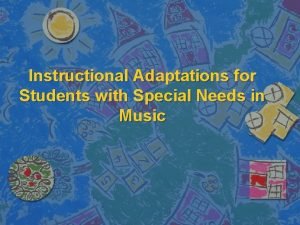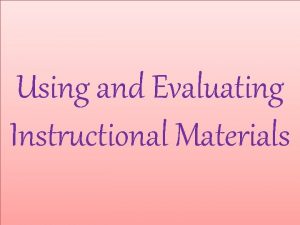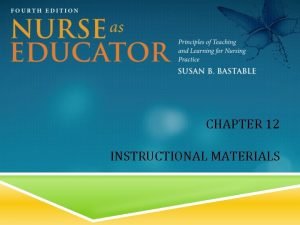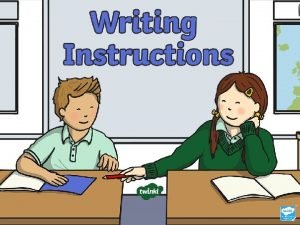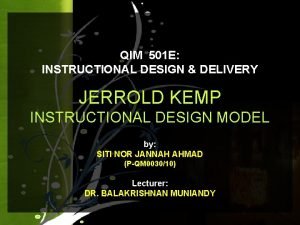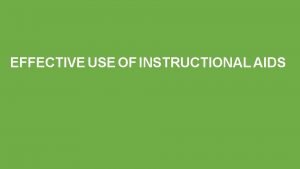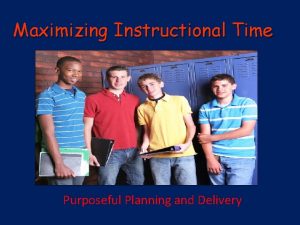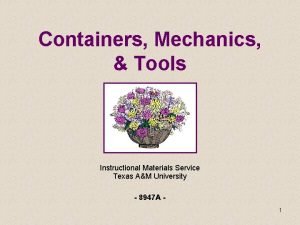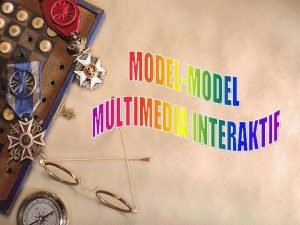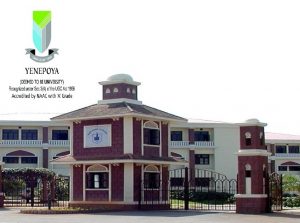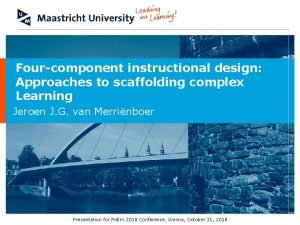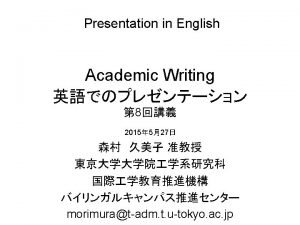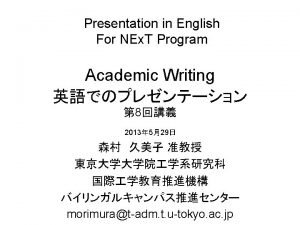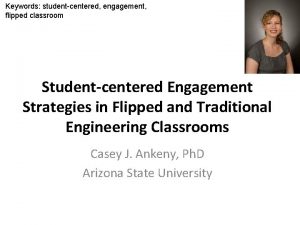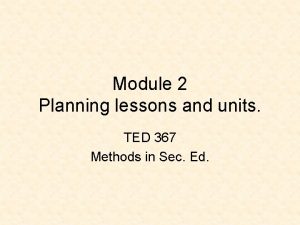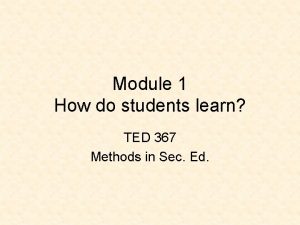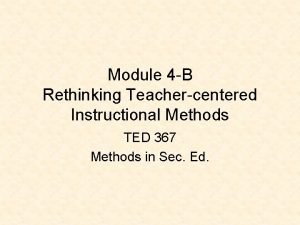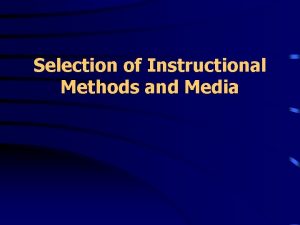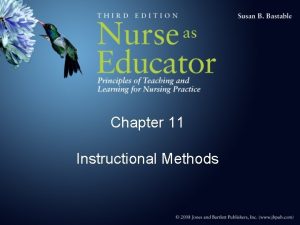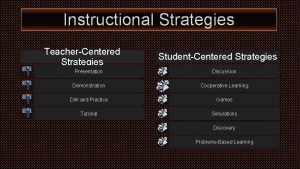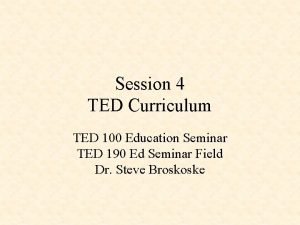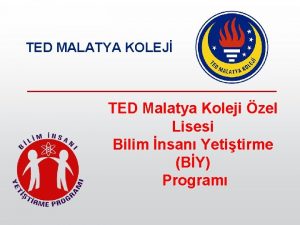Module 4 C Studentcentered Instructional Methods TED 367









































































- Slides: 73

Module 4 -C Student-centered Instructional Methods TED 367 Methods in Sec. Ed.

Reading • Read the following in the Duplass textbook: – Unit 5 (topics 21 -25) Instructional Approaches – Unit 6 (topics 26 -36) Methods

Learning Experiences Ladder Symbolization Abstract • Verbal Experiences – Teacher talk, written words. Engages 1 sense. • Visual Experiences – Graphics, images, charts. Engages 1 sense. • Vicarious Experiences – PC or video programs. Engages several senses. Learner indirectly doing. • Simulated Experiences – Role play, experiment, simulations, working model. Engages nearly all senses. • Direct Experiences Concrete Hands-on Minds-on – Learner actually does what is being learned. Engages all senses. Most effective and long-lasting learning. Engages many senses. Interdisciplinary. Authentic learning.

Student-centered Methods 1. Learning in Pairs (Dyads) 2. Learning in Small Groups 3. Inquiry teaching and discovery learning 4. Project-centered learning 5. Case studies 6. Educational games 7. Field trips (real and virtual) 8. Guest speakers Remember to vary the methods you use!

Learning in Pairs (Dyads)

Learning in Pairs (Dyads) 1. Peer-assisted Learning (PAL) 2. Paired Team Learning 3. Think-Pair-Share

Peer-assisted Learning (PAL) • One student (more skilled) tutors/mentors another (less skilled). – Also known as peer mentoring or tutoring. • Benefits: – Promotes active learning. – Increases academic achievement for both students.

Paired Team Learning • Students study and learn in teams of two. – Gifted students work and learn especially well in this format. • Specific uses: – Drill partners. – Book report pairs. – Homework partners. – Project assignment pairs.

Think-Pair-Share • In dyads: 1. Examine a new concept/topic about to be studied. 2. Discuss what they already know or think about the concept. 3. Present their perceptions to the class. • Benefit: – Discover misconceptions students have about the topic to be studied.

Learning in Small Groups

Learning in Small Groups • Create groups of 3 -8 students. • Students assume greater control over learning. • Grouping: – Personality type. (Less assertive students. ) – Social pattern. (Break up friends. ) – Common interest. – Learning style. – Abilities.

Cooperative Learning Groups • CLG’s are heterogeneous groups who work together, with emphasis on support for one another. • Based on the work of Vygotski argued that learning is most effective when learners cooperate in a supportive learning environment, under guidance of a teacher.

Cooperative Learning Groups • Theory: – When a mixed group of learners works together towards a common goal: • • • Friendship increases. Respect increases. Individual self-esteem is enhanced. Increased higher-order thinking. Learning occurs.

Cooperative Learning Groups • Assign roles such as: – Group facilitator: Keep group on task. – Materials manager: Obtain, maintain, and return materials. – Recorder: Record all group activities and processes. – Reporter: Report progress to teacher/class. – Thinking monitor: Identify and record sequence and processes of group’s thinking. Be sure to rotate students through positions!

Cooperative Learning Groups • For CLG’s to work: – Each group member has 2 tasks: • Perform his/her assigned task. • Ensure others are performing their tasks. – Foster interpersonal skills. – Ensure all students understand their roles. – Rotate roles.

Cooperative Learning Groups • Uses: – Problem solving. – Investigations. – Opinion surveys. – Review. – Project work. – Test making. – Many other purposes.

Cooperative Learning Groups • Benefits: – Improved communication. – More acceptance of individual differences. – Fewer off-task behaviors typically. – Improves thinking strategies (problem-solving, decision-making, critical thinking, creative thinking). – Increases academic achievement.

Cooperative Learning Groups • Grading: – You typically grade based on group achievement. – Options: • You can recognize individual contributions. • You can grade individuals on different standards, based on ability. • Although the group receives a grade, individual learners will be assessed in additional ways later (e. g. , tests, etc. ).

Activity • Create a cooperative learning group activity. – Determine the topic/task. – Determine the number of students per group. – Identify how you will group students (ability, learning style, personality, etc. ). – Identify student roles.

Inquiry Teaching and Discovery Learning

Inquiry Teaching and Discovery Learning • Both methods are based on the assumption that learners would rather actively seek knowledge than receive it through expository methods. • Both methods are based in problem solving. vs.

Inquiry Teaching and Discovery Learning • Problem solving involves: – Define a problem. – Determine desired outcome. – Select possible solutions. – Test trial solutions. – Evaluate outcomes. – (Revise as needed. ) • Differentiation: Who defines the problem, process, and solution?

Inquiry Teaching vs. Discovery Learning These methods differ by who defines problem and process for solving the problem. Problem Process Solution • Teacher or textbook • Student Low End • Teacher or textbook • Student • Student High End

Inquiry Teaching and Discovery Learning Outcomes • You want students to… – Use their skills to address real-world problems. – Develop confidence in their ability to solve problems. – Understand that there are no right/wrong answers to real-life problems. • Help students realize the tentativeness of “answers” to real-life problems.

E-missions. net • 2 -hour videoconference. • Emergency response team: Students form teams to handle different tasks. • Students utilize volcano and hurricane data sent from the (simulated) space shuttle mission. • Emergency bulletins arrive at times. • Incorporates math, science, and practical application.

E-missions. net • Costs $500 per mission. • Requires 5 PC’s and videoconferencing equipment. • Aligned with state standards. • Provide lesson plans. • Provide session available to show benefits to schools, students, and teachers.

E-missions. net e-missions. net

Class Activity/Example • Experience inquiry teaching (discovery learning) as a class. • Topic: Locating a Colony

Activity • Create an inquiry teaching/discovery learning experience. Allow the class to attend the learning activity. – Create a real-life problem to be solved. – Create materials for students: • Background/scenario. • Directions to solve problem. • Provide any additional materials needed (Web sites, maps, graphics, statistics, etc. ).

Project-centered Learning

Project-centered Learning • Projects are: – A hands-on way for students to apply what they have learned. – A relatively long-term investigation (experience). – Culminates in a presentation. • Can include an oral report, a written report, and a hands-on item (e. g. , multimedia presentation, play, song, poem, diorama, poster, chart, display).

Project-centered Learning • Benefits: – Develops social interaction and cooperation. – Develops skills in writing and verbal communication. – Encourages higher-level thinking. – Encourages learning and thinking independence. – Builds self-esteem (student knows much on one topic/area and makes a contribution). – Allows student to exercise control over learning. – Increases motivation.

Suggestions for Projects 1. Helps students select a topic. • • • Provide sample topics. Show other finished projects. Suggest readings, Web sites, and other resources. 2. Let students decide if they want to work in groups. • The project could be a class project divided into sections handled by groups.

Suggestions for Projects 3. Help students stay on-task with progress. • • • Set deadlines. Ask for information on progress. Provide coaching and guidance, and inquire if students have questions/problems. 4. Maintain balance. • • Provide sufficient guidance and coaching so the projects don’t fail. Don’t provide too much guidance or the project becomes a teacher-centered project vs. a studentcentered experience.

Suggestions for Projects 5. Require both a written and oral report. • • Have students write a paper that describes their experience in developing the project vs. doing a traditional research paper. Have students present an oral report to the class.

Suggestions for Projects 6. Make the project a significant part of the student’s grade. • • Make the grading clear (clear rubric). Suggested criteria: ü ü Organization. Quality and quantity. Quality of learning shared with the class. Quality of products (written, oral, and hands-on).

Activity • Create a project-centered learning activity. – Choose a subject. – Provide some sample topics to help guide us in picking a project topic. Picking a topic is one of the most difficult parts of this activity. How will you teach this to your class? – How will you handle deadlines and progress updates? – How will you assess the product(s)? Create a rubric.

Case Studies

Case Studies • Case studies involve presenting a realworld type of problem that students attempt to solve/address. (Remember that in real-world situations, there are no black and white answers. ) • Case studies place students in a problemsolving scenario. • A case may present actual data already collected from a real company/situation.

Case Studies • Students analyze (process) the case: – Determine what is known. – Assess the problem. – Create charts, data tables, etc. as needed. – Determine important vs. unimportant details. • Students determine possible course(s) of action to solve/address the problem. • Deliver a final product: – Written report, multimedia presentation, and/or a classroom presentation.

Advantages of Case Studies 1. Students become active agents in the learning process. 2. Students analyze information and develop solutions to problems. 3. Students develop skills that allow them to think clearly about unstructured, ambiguous situations using incomplete information.

Advantages of Case Studies 4. Students must decipher the underlying motivations of the characters or the causes of events or phenomena. 5. Students must deduce assumptions and principles because cases do not explicitly denote the underlying problems. 6. Ensures that students learn to both listen and talk, regardless of their temperaments. 7. Students develop skills in articulating ideas to influence and persuade others.

Example: Math Case Study • One More Minute Between Classes • The student council has asked the principal to add one more minute between classes, to cut down on the number of students tardy for class. The principal has asked your class to study the matter and make a recommendation.

Example: Math Case Study • Guidelines provided by the principal: – Bus schedules cannot be changed due to after -school activities and bus schedules. – Classes must meet at minimum of 210 minutes a week or 420 minutes every two weeks. – Homeroom time is required. – A multimedia presentation is expected in two weeks. – Be prepared to defend any plan with facts, figures, and charts.

Example: Science Case Study • Humans Affect on the Local Watershed • For humans to survive they need water, however there is only a limited amount of water for everyone to use on the earth. The community is locked in a debate about the appropriate use of existing water supplies and the need to expand business development.

Example: Science Case Study • Last month the local newspaper ran a story about the lack of additional sources of water for the community. The article also stated that unless additional sources of water could be located, the community is at risk of running out of water in 20 years.

Example: Science Case Study • Today the local newspaper has a story about a new industry which wants to move into the community. This industry needs a large amount of water for its manufacturing process. This new industry is expected to add 200 new jobs and provide additional taxes to support the community.

Example: Science Case Study • The local government is going to hold a public hearing on the matter in two weeks. You are to present your view at this hearing.

Activity • Prepare a case study learning activity. – Do an online search for case studies in your field. Select a case study. – Determine the purpose of using the case. What do you want students to gain? – Some case studies provide tasks/questions for learners. Present a task(s) or questions for the learners to address in the case. – How will you assess what the learners have gained from analyzing this case?

Educational Games

Educational Games • Wide range of games: – – – Simulations. Role-play. Drama activities. Board games. Computer games. Sporting games. • Games involve several senses and learning modalities, and tend to engage higher-order thinking skills.

Educational Games • Drama: – Fully engages learner intellectually, emotionally, physically, verbally, and socially. • Role-playing: – Research shows that comprehension increases, and students are motivated to read. • Simulations: – Concrete experiences help students understand complex concepts and issues, and provide opportunities to explore values and build decisionmaking.

Educational Games • Other benefits: – Variety, change of pace, break from other forms of learning. – Motivates students. – Problem-solving experiences. – Connects with real-life experiences. – Tactile and kinesthetic modalities.

Educational Games • Sources of games: – Journals. – Download. com. – Internet.

Field Trips (Real and Virtual)

Field Trips • Field trips provide a different context, stimulus, and voice than the teacher-led classroom. • Can be used as a motivating device. • A briefing and debriefing should be part of the instructional sequence.

Best Practices for Field Trips 1. Make a pre-trip visit before deciding to take students. 2. Take the time to meet with your administration and explain your educational goals. 3. Decide if you will run the tour or if a guide from the venue will do so. 4. Verify and confirm all arrangements in writing. 5. Make arrangements for students with special needs.

Best Practices for Field Trips 6. Create clear rules about conduct for the students. 7. Review appropriate conduct and attire with students. 8. Invite parents to serve as additional supervisors. 9. Create an attachment to the school’s standard permission slip that includes a statement of the educational goals.

Best Practices for Field Trips 10. Take roll call before, during, and after the trip to keep track of students. 11. Preview and debrief the trip with students. 12. Provide each student with a guide sheet, questions to answer, or specific tasks to complete while on the trip. 13. Provide instruction before and after the trip.

Virtual Field Trips • An alternative to a “real” field trip is the virtual field trip. – Less required time. – No travel logistics. • Permission slips, lunch, transportation. – Inexpensive. – More in control of experience. – Due to less required time, you can take your class on more virtual trips.

Virtual Field Trips • As with actual field trips, be sure to do the following when taking students on a virtual field trip: 1. Preview and debrief the trip with students. 2. Provide each student with questions to answer or specific tasks to complete while on the trip. 3. Provide instruction before and after the trip.

Virtual Field Trips Virtual FT Virtual. Free. Sites. com

Demonstration Egypt Pyramid US Supreme Court Stonehenge

Activity • Electronic field trip and educational games. For each: – Describe guidance you would provide to the learners for field trip. – Explain how/when you will use this activity. – How much time will you spend? – How will you determine if students have learned from this activity? – Describe how these methods benefit learners compared to traditional lecture.

Guest Speakers

Guest Speakers Powerful… • Guest speakers provide a different context, stimulus, and voice than the teacher-led classroom. • Guest speakers invited into your classroom can provide powerful learning experiences. • Guest speakers are a classroom “unknown. ” They can be disasters. …or disaster

Best Practices for Guest Speakers 1. Before extending the invitation: preview the speaker OR meet with the speaker OR call a reference who saw a presentation. • Deciding to invite the speaker solely on the basis of a brief phone conversation is extremely risky. 2. Obtain your principal’s approval.

Best Practices for Guest Speakers 3. Communicate all the arrangements verbally and in writing. 4. Clearly state the focus of the presentation and your expectations. 5. Limit the time to no more than twothirds of your class time.

Best Practices for Guest Speakers 6. Encourage an active presentation based on active learning strategies. 7. Encourage guest speakers to use Realia, music, artwork, primary documents, pictures, apparatuses, handouts, and visual aids.

Best Practices for Guest Speakers 8. Suggest the value of storytelling and anecdotal stories, and warn the speaker to avoid preaching. 9. Prepare students by reviewing etiquette. 10. Provide instruction about the topic as part of a comprehensive lesson before and after the presentation.

Best Practices for Guest Speakers 11. Require students to prepare questions for the visitor. 12. Give students specific assignments to be completed as a result of the presentation.

n o i s s u c s Di Guest Speakers • Guest speakers can engage learners by allowing them to interact with people who experience the topic in a hands-on way. ØWhat topic might you want a guest speaker to present? ØWhat benefits will be served by having a guest speaker present this topic? ØWhere (what profession or talent/skill) might you find a guest speaker?

Review: MODULE 4 -C 1. 2. 3. 4. 5. 6. 7. Learning in pairs (Dyads). Learning in small groups. Inquiry teaching and discovery learning. Project-centered learning. Educational games. Field trips (real and virtual). Guest speakers.
 Cs 367
Cs 367 Lner v berriman
Lner v berriman Cs367
Cs367 R v allen 1872
R v allen 1872 Rounding to the nearest hundred thousand
Rounding to the nearest hundred thousand Cmput 367
Cmput 367 Difference between direct and indirect instruction
Difference between direct and indirect instruction Whitely v chappel (1868)
Whitely v chappel (1868) R v allen (1872) lr 1 ccr 367
R v allen (1872) lr 1 ccr 367 Self instruction definition
Self instruction definition C device module module 1
C device module module 1 Wax pattern in dentistry
Wax pattern in dentistry Visual instructional materials
Visual instructional materials Parts of flower
Parts of flower Gagne-briggs model
Gagne-briggs model High-yield instructional strategies
High-yield instructional strategies Instructional materials definition
Instructional materials definition Instructional walkthroughs
Instructional walkthroughs Katie conley model
Katie conley model Advantage and disadvantage essay introduction
Advantage and disadvantage essay introduction Kemp's instructional design model
Kemp's instructional design model Tads hisd
Tads hisd Data driven instruction cycle
Data driven instruction cycle Dick carey model
Dick carey model Instructional learning cycle
Instructional learning cycle Task analysis instructional design
Task analysis instructional design Conclusion of educational objectives
Conclusion of educational objectives Instructional aims
Instructional aims Definition of instructional technology
Definition of instructional technology Examples of accessible instructional materials
Examples of accessible instructional materials Components of good teaching
Components of good teaching Marzano's 9
Marzano's 9 Marzano instructional strategies
Marzano instructional strategies Heograpiya ng boracay
Heograpiya ng boracay Class domains and dimensions
Class domains and dimensions Instructional practice guide
Instructional practice guide Self-instructional training example
Self-instructional training example Instructional software definition
Instructional software definition Stages of instructional hierarchy
Stages of instructional hierarchy Instructional game
Instructional game Instructional procedures examples
Instructional procedures examples Ccccio
Ccccio Instructional designer anzio
Instructional designer anzio Deca roleplay rubric
Deca roleplay rubric Special circumstances instructional assistance assessment
Special circumstances instructional assistance assessment Types of instructional materials
Types of instructional materials Sic architecture
Sic architecture Disadvantages of cognitively guided instruction
Disadvantages of cognitively guided instruction Goal analysis instructional design
Goal analysis instructional design 7 forms of bias in instructional materials
7 forms of bias in instructional materials Visual instructional media
Visual instructional media Instructional objectives
Instructional objectives Teaching media definition
Teaching media definition Marzanos instructional strategies
Marzanos instructional strategies Comparing instructional design models
Comparing instructional design models Jacob kounin
Jacob kounin Instructional adaptations for special needs students
Instructional adaptations for special needs students Harvard instructional rounds
Harvard instructional rounds Hayden smith and thomas nagel
Hayden smith and thomas nagel Streamline learning
Streamline learning Still projected display materials
Still projected display materials Slidetodoc
Slidetodoc Kemp design model
Kemp design model Sam instructional design model
Sam instructional design model Instructional aids examples
Instructional aids examples California community college chief instructional officers
California community college chief instructional officers Elps texas
Elps texas Maximizing instructional time in the classroom
Maximizing instructional time in the classroom Instructional materials service
Instructional materials service Contoh model instructional games
Contoh model instructional games Disadvantages of gagne's instructional events
Disadvantages of gagne's instructional events What are the objectives of micro-teaching
What are the objectives of micro-teaching Ask fhml
Ask fhml Concept of instructional and communication technology
Concept of instructional and communication technology
